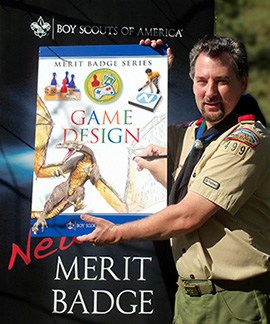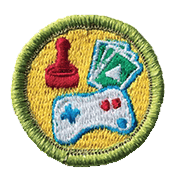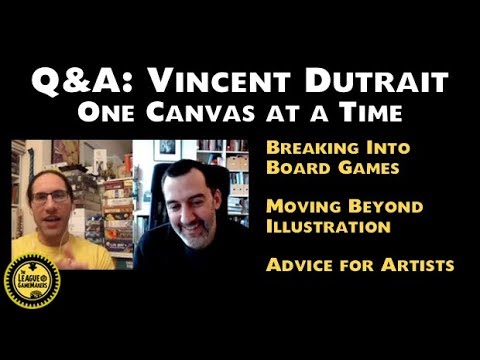
David Mullich is a video game designer and consultant, and a game production instructor at The Los Angeles Film School. We’ve ‘met’ David through twitter – he’s active in social media discussing game theory, gamification and variety of design topics. We asked him to tell the story of a unique item in his design credentials…

Of all my accomplishments during my thirty-five years designing and producing video games, one of which I am the most proud is my involvement in creating the Game Design Merit Badge.
The Boy Scouts of America’s merit badge program is designed to introduce scouts to potential career or hobby interests, as well as give boys experience in interacting with adults (in this case, merit badge counselors) and earning recognition for accomplishments.
Game Design is the 131st badge on the active list and was officially added to the program on March 6st, 2013.
ORIGIN AND APPROVAL OF THE MERIT BADGE
The idea for a merit badge focusing on Game Design came from a board game enthusiast named Tom Miller in 2009. After spending four to six months just finding the right person to talk to at about the idea, Miller convinced BSA National to investigate whether there was a broad-based interest in game design among scouts nationally. Miller was eventually joined in his efforts by another game enthusiast, David Radue, who provided the BSA with information about the size and growth of the game industry. After obtaining formal approvals from both the Advancement Committee and overall Program Committee, Miller and Radue began putting together a team of game design experts to put together the merit badge requirements.

I was invited to join the team in September 2011 upon the recommendation of Mike Zyda, director of the University of Southern California GamePipe Lab. BSA National had wanted an academic to be part of the team, and so Miller approached Zyda because USC’s game program was rated the top rated college-level game development educational program in the country. However, Zyda was too busy to become involved and recommended me instead because, even though I am not an academic, I had served as a game industry mentor to some of his GamePipe Lab students and I was actively involved in my two sons’ Boy Scout troop.
Our team, with over a dozen game industry professionals, met online and came up with the following requirements for scouts to fulfill for investigating a career in game design.
ANALYSIS, LANGUAGE OF DESIGN AND PROCESS
We begin scouts with analyzing four different games that they’ve played, each from a different medium (board game, card game, electronic game, physical game, etc.). They must make a chart comparing and contrasting the games in terms of player format, objectives, rules, resources and theme. We also have scouts describe different types of play value and a game built around each. (The philosophy we present on what makes games fun to play was based upon UbiSoft Creative Director Jason Vanderberghe’s “Domain of Play” presentation given at the 2012 Game Developers Conference and is used with permission).
Next, we have scouts learn about the language of game design, and so we have them define five out of seventeen game design terms: thematic (story, setting, characters), gameplay (play sequence, level design, interface design), game analysis (difficulty, balance, depth, pace, replay value, age appropriateness), and related terms (single-player vs. multiplayer, cooperative vs. competitive, turn-based vs. real-time, strategy vs. reflex vs. chance, abstract vs. thematic).
Before we have scouts start designing their own game, we thought it was very important to teach them about the concept of intellectual property, especially with regards to games, how it is protected, and why it is protected. This was just not to prevent them from ripping off another scout’s concepts (after all, as professional game designers know, game concepts are a dime a dozen), but we didn’t want them using copyrighted artwork in creating their game prototypes.
We also wanted scouts to learn that game design is an iterative process in which the game design is not creating a game for his own entertainment but rather is trying to create an experience that will entertain others; however, our guesses about what is fun for others is often wrong, so it is important to test out our games with actual players. So, we have scouts take a game that they’ve played before, write out its rules, and then proceed to make changes to the rules. For each rule change, the scout must make a predication about how the change will affect players’ actions and experiences, observe how players playing the game with that rule change, and then record how the players’ actions and experiences are affected by the rule change. This they must do three times.
DESIGNING A GAME

Now scouts are ready to begin designing their own game. Their next requirement is to write out a vision statement (describing the medium, player format, objectives, resources and theme), play value description, and preliminary set of rules for their game. However, before proceeding on to creating a prototype, they must meet with their local Game Design merit badge counselor to discuss the game concept. Once the scout obtains the merit badge counselor’s approval, he can begin making a prototype of his game.
The scout must test his prototype with as many people as are needed by the player format. As he observes the players to see whether the play experience matches the play value goal, he must correct any unclear rules, holes in the rules, dead ends, and game exploits the players encounter. Then the scout must change a rule, mechanic or objective from his original version of the game, observe players play the game using that change, and then record the results in his Game Design Notebook. He must do so at least three times before creating a final version of his game.

INVESTIGATE CAREERS IN DESIGN
The final requirement for earning the merit badge is to investigate careers in the game industry, either by interviewing a game professional or instructor, or by doing research into different game job functions and requirements.
To assist scouts with learning what they need to know to earn their merit badge, we wrote a 96-page pamphlet covering many different game design topics (I wrote the chapters on prototyping and play testing).
PAMPHLET EXCERPT
FUTURE DESIGNERS
The Game Design Merit Badge was formally announced at the 2013 South by Southwest Festival (SWSX) in Austin, Texas. The BSA said in the press announcement,
“GAMES MOTIVATE BOTH YOUNG AND OLD TO FIND CREATIVE SOLUTIONS, PRACTICE NEW SKILLS, AND KEEP THEIR BRAINS ACTIVE.”
I couldn’t agree more. In the past year-and-a-half that I’ve been a merit badge counselor, I’ve run several Game Design workshops and am constantly amazed at the passion and creativity that scouts have displayed when creating their own games. The Dutch historian Johan Huizinga stated that play was perhaps the primary formative element of human culture, and so it gives me great satisfaction and hope for the future to teach kids how to create more play for the world to enjoy.








